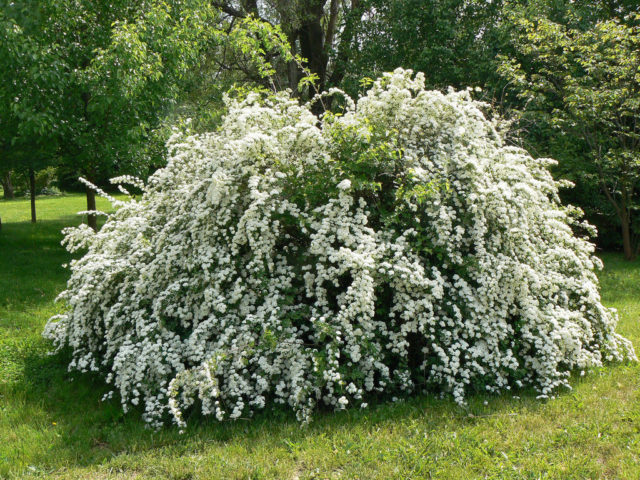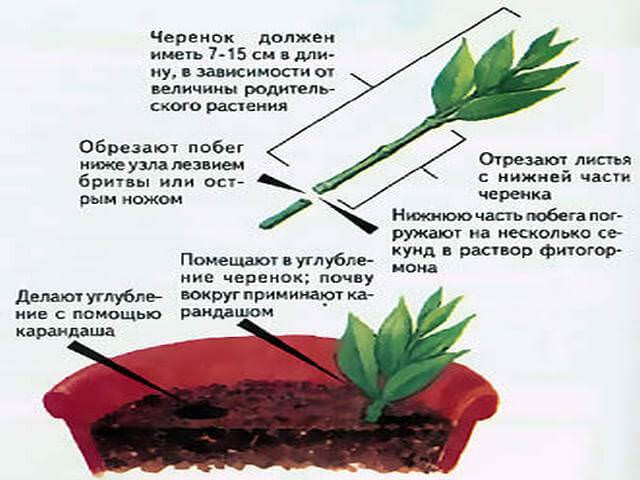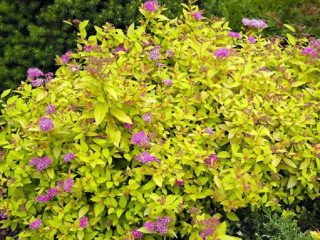Content
Even a novice gardener can propagate spirea. The shrub takes root well in a new place and does not require special care.
Peculiarities of reproduction of spirea shrubs
It is most effective to propagate spirea in early spring or autumn, when there is enough natural moisture in the soil for the shrub to take root. However, experienced gardeners successfully breed it in the summer.
Spring reproduction is planned until the buds swell. Usually this is mid-March, but the timing may vary in different regions. If time is lost, you will have to wait until active leaf growth stops. As a rule, this happens in late spring, when the spirea is preparing to bloom.
Reproduction of shrubs in summer is possible, but only if the weather is cloudy. It is very important that the young plant does not lose moisture. Intense heat and lack of water negatively affect the survival rate of spirea. Work is planned for early or mid-June. If the spirea is still blooming at this time, then propagation will have to be postponed for several weeks.
Autumn propagation of spirea should be completed several weeks before the first frost. The work is planned for mid-September, but planting can be extended until the first days of October. Autumn breeding has the most advantages. Gardeners are pleased with the fact that young plants do not need constant care; it is enough to insulate them for the winter. In summer and spring, spirea needs constant spraying and watering, without which the survival rate of planting material is low.
How does spirea reproduce?
The most common way to propagate spirea is to root cuttings. Young plants retain all varietal characteristics and take root well. Absolutely all shrub hydrides are easy to take from cuttings.
There are also proven methods for propagating spirea, which, with the right approach, give good results:
- dividing the bush;
- withdrawal method;
- seeds.
The latter method is only suitable for varietal plants; it makes no sense to propagate hybrid spirea using this method.
Propagation of spirea by cuttings
Spiraea can be propagated using lignified or green cuttings. It all depends on what time of year the rooting takes place. Cuttings are taken from annual or last year's shoots. It is easy to distinguish them - on the new growth the bark is still light.
When to cut spirea
Cuttings of spirea are possible in early spring and summer, as well as in autumn. You need to harvest shoots in cloudy weather. Planting material is cut from a healthy bush. If the spirea shows signs of damage by pests or diseases, then you first need to treat the mother plant. Spraying is repeated if necessary. You can prepare cuttings for further propagation no earlier than after 3 days.
How to propagate spirea by cuttings in spring
In spring, spirea is propagated using lignified cuttings. Last year's ripened branches are used, the thickness of which is no more than 0.5 cm. Cuttings are cut from the middle of the shoot. The lower cut is made oblique, and the upper cut is made straight. Each prepared cutting should have 5-6 buds. Small cuts are made above the bottom two to stimulate root formation.
You can root cuttings in the spring directly in the soil or in a container, followed by transplanting to a permanent place.
Algorithm of actions:
- For rooting in a container you will need a loose substrate, sand, and drainage.
- Expanded clay is poured onto the bottom of the container, then a layer of fertile soil and sand.
- The cuttings are pre-soaked in a solution of “Kornevin” or another growth stimulant.
- The lower cut is buried 2-3 buds so that it does not touch the soil, but is in a layer of sand. This will prevent rotting and increase the survival rate of planting material.
After planting, the container is placed in a greenhouse. It takes up to 1 month for roots to form. All this time you need to ventilate and, if necessary, water the plantings.
In open ground, cuttings are rooted in the same way, with the only difference being that they are planted immediately in a permanent place or in a school. To make root formation faster, the plantings are regularly sprayed with a spray bottle.
How to propagate spirea by cuttings in summer
In summer, green cuttings are chosen for propagation of spirea. The tops of young shoots are cut off, as they can rot or break off during the rooting process.All lower leaves are torn off from the prepared cuttings, leaving only the top 4 leaves, while the leaf blade is shortened by a third.
The lower cut is treated in a solution of potassium permanganate, after which the cuttings are planted in a nutrient substrate. The shoots are buried by 1.5-2 cm. The distance between them is maintained at about 3 cm.
Choose a place for rooting that is shaded from the scorching sun, but well ventilated. The plantings are covered with glass or a bag to create a greenhouse effect. The cuttings are periodically ventilated. They are transferred to a permanent place when the shoots begin to grow.
How to propagate spirea by dividing the bush
Reproduction of spirea, which has reached the age of 3-4 years, can be carried out by dividing the bush. It is difficult to divide older plants in this way without damaging the root system.
You can propagate perennials by division at any time of the year, but it is better to do this in the fall. Gardeners recommend planning work for early September. At this time, the shrub requires minimal care. In summer it is more difficult to divide; it is better to do it in cloudy weather or when it rains.
The spirea is dug up, placed in a bucket of water for several hours, after which it is divided into 2-3 divisions. Use sharp pruning shears that are pre-disinfected. Before planting, the roots of plants are trimmed and transferred to prepared holes.
Propagation of spirea by seeds
One way to propagate spirea is to grow seedlings from seeds. This method allows you to obtain a lot of planting material. Seeds do not require special preparation or stratification. They are collected in the summer, and planted in the fall or spring.
For this:
- Seed pods are harvested in late July - early August.
- They are ripened for 3 weeks at home.
- For planting, loose soil is used, which is filled with containers.
- The seeds are evenly distributed over the surface of the soil and lightly sprinkled.
- The plantings are well sprayed with a spray bottle and covered with a bag for a greenhouse effect. When shoots appear, the package is removed.
The seedlings sprout in a few months, by which time they will reach a height of 2 cm.
Instructions:
- The plants are planted in a box, leaving a distance of 7 cm between them.
- After this, the container with the seedlings is put into the garden for the summer, so that it is not exposed to direct sunlight.
- Young seedlings are watered abundantly; the soil should not dry out, as weak roots will quickly die.
In autumn, the sprouts are transplanted into open ground, where they overwinter. In spring, plants are given a permanent location. Flowering of young bushes will begin after 3 years of cultivation.
How to propagate a spirea bush by layering
If you need to get only a few shoots from a bush, it is most convenient to propagate spirea using the tapping method. Work is planned for early spring. Select the lower shoots, break them slightly, pin them to the ground and cover them with soil.
All inflorescences are cut off from the mother bush so that energy is spent on the formation of roots in young shoots. The soil under the perennial is kept moist. By the end of the season, the cuttings will have formed a good root system, but it is too early to replant them. For the winter, the plants are hilled up and covered with dry leaves. They are transplanted to a permanent place in the spring.
Advice from experienced gardeners
In order for spirea to develop well after rooting and delight you with flowering, you need to follow simple rules:
- For planting in a permanent place, prepare a deep hole that is 3 times the size of the root system. The bottom is well drained with broken bricks, pebbles and sand.
- The hole is filled with a nutritious substrate of garden soil, peat and sand. The components are mixed in a ratio of 2:1:1
- The seedling is lowered into the hole so that the root collar remains level with the soil.
- After planting, spirea is mulched with humus and watered abundantly.
If there are several plants on the site, then you need to maintain a distance of up to 1 m between them. To create a hedge of spirea, the plants are planted more densely; it is enough to leave 40-50 cm between them.
The first years after rooting, perennials need careful care. At this moment, the shrubs are acclimatizing. Water them regularly; the root system should not dry out. In rainy weather, there is no need to additionally moisten the soil.
During the growing season, the perennial must be fed with liquid mineral mixtures and organic matter. In winter, the soil under the plant is mulched with dry leaves, the shoots are tied and covered with spruce branches. The first time pruning spirea is done after wintering.
Conclusion
Spiraea can be propagated in different ways. It is important to correctly determine the method and time of the procedure. Beginners should stop at cutting shrubs, gradually learning more complex methods.














